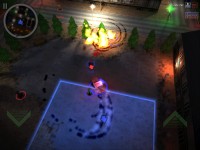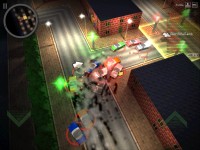
Behind The Scenes / 10 September 2012
Introduction
|
Welcome to first Payback 2 Dev Diary! We had originally planned to write just one short article, but it's such a big game and so much has changed since the first game 3½ years ago that unfortunately we couldn't fit everything in without splitting it up!
|
Design
|
One of the major changes in Payback 2 is that the game is now event based - think GTA meets Quake III Arena, although with more variety than the latter. This allowed us to make the game more accessible and is a better fit with how people usually play mobile games.
Of course, the game also allows you to design custom events that can be as long as you like, and also supports the first game's classic "Rampage" mode that allows traditional GTA-style sandbox gameplay.
Other big changes include the creation of some exciting new weapons (auto-turrets and lasers, for example) and game modes - but we don't want to spoil all the surprises here!
|
AI
|
Another significant addition is that most events are now played against AI opponents (or a mixture of humans and bots in multiplayer). This makes the events less predictable and helps longevity.
As you can imagine, making AI capable of playing competitively in a huge sandbox environment with all the vehicles, game modes and weaponry available in Payback 2 was a big challenge, but we're very pleased with the results.
The AI opponents are a genuine challenge on the harder difficulties, without just being aimbots - we tried hard to make them behave like real human players, even simulating human reaction times and weapon change times to keep things fair.
|
Hardware Rendering
|
One unusual aspect of the first game was that it used a software renderer. This was mainly because the GPUs in early iOS hardware were so slow that our software render was actually faster!
However, with the advent of higher resolution displays and much faster GPUs, it was time to bite the bullet and rewrite the graphics engine from the ground up for iOS. As you can imagine, this was a major undertaking, but it allowed us produce a really optimised renderer that achieves a full 2048x1536@60Hz on the new iPad. (The previous game got 480x320@30Hz, at best!)
|
Lighting & Effects
|
One of the hardest things to render with the GPU was the game's HDR lighting. This tech allows every surface to have a unique lightmap which has very high quality lighting baked into it. All these textures take up a huge amount of room unless compressed with our custom codec, which of course can't be natively rendered by the GPU.
We experimented with several different approaches to solving this problem, before eventually settling on a system that dynamically builds the appropriate texture atlases for chunks of the environment on a separate thread as you move around.
We also added many post processing effects such as dirt and blood on the camera, vignetting, glare, blurring and tinting. Last but not least, most of the 3D models from the first game have been improved or replaced completely (The pedestrians, for example, have ten times the polycount as in the first game!)
|
Next Time
Next >>
|
|



More media >>
|
|

